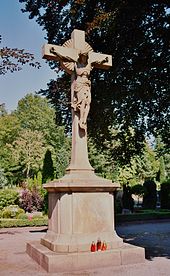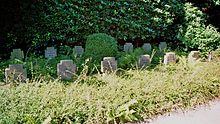Ibbenbüren Central Cemetery
The Ibbenbüren Central Cemetery , sometimes unofficially also called the North Cemetery , is one of the two large cemeteries in the Ibbenbüren district . The cemetery is located in the north of the city center between the streets An der Reichsbahn , Bockradener Straße , Am Friedhof and Nordstraße . With its 7.6 hectares , it is the largest cemetery in Ibbenbüren in terms of area after the main cemetery.
history
After the cemetery on Schulstrasse in the city center had reached its capacity limits, the city of Ibbenbüren decided to create a new, larger cemetery outside the city center. After lengthy negotiations starting in 1914, the site north of the railway was finally bought in 1916 for 48,000 Reichsmarks . The city's new central cemetery was built there in 1918/19 based on the Jewish cemetery . It was expanded in various ways in 1940, 1948, 1955 and 1963.
Originally it was planned to only use the cemetery until the 1980s and to use it as a public green area after 2000 . The main cemetery , newly created in 1975/76, was to serve as the future burial site . However, in 1982 the city administration and city council moved away from this plan. After a corresponding change in the cemetery master plan, the occupancy of the cleared row grave areas and returned election graves in the central cemetery increased again. There are currently (as of 2012) around 200 burials there every year. This means that this cemetery is used the most in comparison to the other cemeteries in the city.
In order to cope with this heavy use, the city began in 2006 to renew the main route axis for an estimated total cost of 244,000 euros. This affected parts of the pavement including drainage as well as the water pipe. Parts of the retaining walls were also renovated.
In September 1998 violent gusts of wind knocked down numerous strong old trees or seriously damaged them in the central cemetery. Nonetheless, the central cemetery is still largely characterized by a park-like character and one of the “green lungs” of the city center. Various large-crowned deciduous and coniferous trees contribute to this. In 2008 the heavily thinned hedge facing the streets Am Friedhof and Bockradener Straße was replaced by a new hornbeam hedge.
The numerous water points are uniformly designed from sandstone as a fountain basin.
Burial facilities
In contrast to the main cemetery established in 1975/76, the burial facilities in the central cemetery are much more conventional. The municipal cemetery administration offers row , children's and elective graves as earth graves or urn graves . In addition, the cemetery statutes set very narrow limits on the design of graves. For example, only natural stones are allowed, but not concrete , glass , enamel and plastic .
The mourning hall has 50 seats.
particularities
There are three architectural monuments of the city of Ibbenbüren on the site of the central cemetery . They are:
The cemetery cross
The cemetery high cross from 1919 is the focal point of the central cemetery, which at the same time clearly shows its fundamentally Christian, albeit not confessional, orientation. The crucifix stands on a high base with rounded corners and a cover plate. Based on baroque tradition, the cross with the body is in the "four-nail type". The “object of popular piety” was entered in the list of monuments of the city of Ibbenbüren in 2000 (inventory no. A 113) and has been a listed building since then.
Többen race grave site
The striking tomb made of Ibbenbüren sandstone in the style of the 1920s is not far from the cemetery cross. Several members of the Többen-Rennen family of industrialists found their final resting place in the grave. The central eye-catcher of the system is a curved attachment with a semicircular niche in which there is a crucifix made of cast metal. The border and the eight grave slabs are also made of sandstone. The grave site was entered in the list of monuments of the town of Ibbenbüren in 2000 (inventory no. A 112) and has been a listed building since then.
Soviet cemetery
This burial ground is located in the northern part of the central cemetery. The formative, obelisk-like monument made of sandstone can already be seen from the street Am Friedhof . On a stepped base there is a cube and on top of it an elongated pyramid , crowned by a five-pointed star ( Soviet star ). Piers connected with iron chains serve to frame the monument. The cemetery was laid out in 1946 at the instigation of the Soviets as a resting place for deceased prisoners of war - Russians, Poles and Czechs who had to do forced labor in Ibbenbüren. These were initially buried in various places in the city, for example in the Heldermann Park, in the garden of the old rectory on Kanalstrasse, as well as in the old cemetery on Schulstrasse and in some places on the central cemetery. In 1947 they were relocated to this burial ground, which is popularly known as the “Russian cemetery” or “Russian cemetery”. The obelisk was erected in 1949, and the initially provisional, simple wooden crosses on the grave sites were replaced by pillow stones. The names of the deceased are recorded on these sandstone tablets. A text panel is embedded in the obelisk. Their Cyrillic inscription reads:
“The bones of 45 Soviet nationals rest here. They were destroyed in fascist captivity. "
According to a list in the Ibbenbüren city archive, the burial ground was even laid out for 46 prisoners of war, including four children.
The burial ground, classified as an “object of popular piety” regardless of its communist - atheist orientation, was entered in the list of monuments of the city of Ibbenbüren in 2000 (inventory no. A 114) and has been a listed building since then. The reason given was:
“This part of the cemetery is important for historical reasons - as a reminder of the victims of the Second World War, especially the slave laborers from the former Soviet Union. There are historical reasons for the preservation - the design of the cemetery is one of the typical post-war cemeteries for war victims. "
More graves of victims of World War II
In a special field in the central cemetery, rows of graves were laid out for the German soldiers who died in Ibbenbüren's hospitals during the Second World War . In these early in 1946 pre-designed military graves 56 fallen soldiers are buried. 19 civilians who were killed in bombs in the area are also resting in the cemetery.
Deviating in part from the above figures, the Volksbund Deutsche Kriegsgräberfürsorge states that a total of 135 victims of World War II are buried in the central cemetery, 79 of them from Germany , 41 from the Soviet Union , 12 from Poland , 2 from France and 1 from the Netherlands . Their graves were cared for for many years on a voluntary basis by Josef Rohlmann and Karl Meyer, members of the KAB St. Mauritius. Since 2011, the Ibbenbüren Reserve Society has been taking care of the German soldiers' graves on a voluntary basis.
Graves of famous people
The grave sites of numerous well-known Ibbenbüren citizens are located in the central cemetery, including


- Richard Borgmann , entrepreneur and, as a local politician, District Administrator of the Tecklenburg district, † 1966
- Konrad Grebe , Steiger and inventor of the coal plane , † 1972
- Horst Aloysius Massing , doctor, specialist journalist and local politician, † 2011
- Hubert Rickelmann , local history researcher and author, † 1961 - the grave was leveled after the rest period had expired in 1997
- Anton Rosen , teacher and local researcher, † 1979
- Karl-Heinz Schäfer , civil engineer and building contractor, † 2011
Others
A curious accident occurred in 2010 when a Smart on Nordstrasse came off the left of the lane, broke through an iron railing in the central cemetery and fell down the six-meter-deep embankment near the cemetery chapel and landed on a family grave.
Web links
- The central cemetery on the website of the city of Ibbenbüren
Individual evidence
- ↑ a b c d e f The central cemetery on the website of the city of Ibbenbüren; Retrieved August 26, 2012
- ↑ The old cemetery was closed for general burials in 1919 and finally closed in 1972.
- ^ Anton Rosen : 5000 years of tombs . In: Ibbenbürener Volkszeitung of October 27, 1973
- ↑ -fpn-: 94,000 euros for the first section . In: Ibbenbürener Volkszeitung , online version of June 3, 2005 ( memento of November 25, 2015 in the Internet Archive ) in the Westline local archive; Retrieved August 26, 2012
- ↑ City: No liability for damage to the cemetery . In: Ibbenbürener Volkszeitung from September 11, 1998, here as online documentation
- ↑ NN: The two sides of a hedge . In: Ibbenbürener Volkszeitung , online version of May 16, 2008 ( memento of February 12, 2013 in the web archive archive.today ) in the Westline local archive; Retrieved August 26, 2012
- ↑ See -bil-: "Uniformity must be maintained" . In: Ibbenbürener Volkszeitung , online version of 1 March 2005 ( Memento of 13 February 2013 Web archive archive.today ) in West Line-local archive; Retrieved August 26, 2012
- ↑ Information on the monument no. A 113 on the website of the Ibbenbüren City Museum ; Retrieved August 26, 2012
- ↑ Information on the monument no. A 112 on the website of the Ibbenbüren City Museum ; Retrieved August 26, 2012
- ↑ a b c d Werner Suer: Care for prisoners of war in the "Waldfrieden" military hospital . In: Ibbenbürener Volkszeitung , online version of March 22, 2003 ( Memento of February 12, 2013 in the web archive archive.today ) in the Westline local archive; Retrieved August 26, 2012
- ↑ Information on the monument no. A 114 on the website of the Ibbenbüren City Museum ; Retrieved August 26, 2012
- ↑ Information from the city of Ibbenbüren on the graves of honor in the central cemetery; Retrieved August 26, 2012
- ↑ War cemeteries on the website of the Volksbund Deutsche Kriegsgräberfürsorge ; Retrieved August 26, 2012
- ↑ NN: Volunteers maintain war graves . In: Ibbenbürener Volkszeitung , online version of October 31, 2002 ( Memento of December 10, 2015 in the Internet Archive ) in the Westline local archive; Retrieved August 26, 2012
- ^ Profile of the Ibbenbüren reservist comradeship ; Retrieved August 26, 2012
- ↑ Oliver Langemeyer: Mettinger family history behind conifers . In: Ibbenbürener Volkszeitung , [http://www.ivz-online.de/lokales/kreis_steinfurt/mettingen/1318621_Mettinger_Familiengeschichte_hinter_Koniferen.html online version from May 11, 2010] (link not available)
- ↑ Mysterious accident: Smart falls on Ibbenbürener Zentralfriedhof , online version from June 21, 2010 on the Westfälische Nachrichten website ; Retrieved August 26, 2012
Coordinates: 52 ° 16 '55.2 " N , 7 ° 42' 54.4" E









